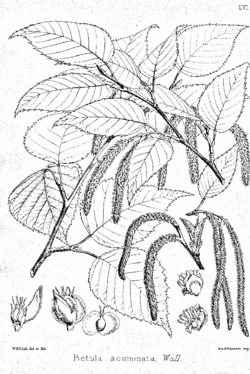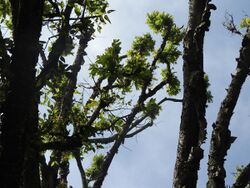Biology:Betula alnoides
| Betula alnoides | |
|---|---|

| |
| Scientific classification | |
| Kingdom: | Plantae |
| Clade: | Tracheophytes |
| Clade: | Angiosperms |
| Clade: | Eudicots |
| Clade: | Rosids |
| Order: | Fagales |
| Family: | Betulaceae |
| Genus: | Betula |
| Subgenus: | Betula subg. Betulaster |
| Species: | B. alnoides
|
| Binomial name | |
| Betula alnoides Buch.-Ham. ex D.Don
| |
| Synonyms | |
|
Betula acuminata Wall.[2] | |
Betula alnoides (Chinese: 西桦; pinyin: xi hua; Thai: กำลังเสือโคร่ง, RTGS: Script error: The function "transl" does not exist., literally: "tiger power") is a species of birch that can be found in natural condition of such countries as Bangladesh, Bhutan, Cambodia, China , India , Laos, Myanmar, Nepal, Thailand and Vietnam at an elevation of 300–2,100 metres (980–6,890 ft) and higher in some cases (up to 2,700 metres (8,900 ft)).[3][4][5][6][7] The southernmost of all known birch species, whose natural range reaches approximately 12° N in Cardamom Mountains, Cambodia.
Description
The plant is 30 metres (98 ft) tall with white coloured branches. It has 1.5–3 centimetres (0.59–1.18 in) long petioles and has a 2.5–5.5 centimetres (0.98–2.17 in) long leaf blade that is lanceolate, ovate, papery, and even elliptic. The female inflorescences a pendulous and cylindric raceme, that, by time it matures, reaches a diameter of 5–10 centimetres (2.0–3.9 in) by 4–6 millimetres (0.16–0.24 in). The peduncle is 2–3 millimetres (0.079–0.118 in) long while the diameter of the bracts is only 3 millimetres (0.12 in). The seeds are ripe from March to May and are 1.5–2 millimetres (0.059–0.079 in) long while the flowers bloom from October to January.
Uses
Betula alnoides inner bark is edible and is used for making cakes and bread. It is also considered to be an antidote against snakebites and is used to treat dislocated bones.[7]
References
- ↑ Shaw, K., Roy , S. & Wilson (2014). Betula alnoides. The IUCN Red List of Threatened Species 2014. doi:10.2305/IUCN.UK.2014-3.RLTS.T194256A2306879.en. https://dx.doi.org/10.2305/IUCN.UK.2014-3.RLTS.T194256A2306879.en. Retrieved 2022-08-05.
- ↑ "Betula acuminata Wall. — The Plant List". http://www.theplantlist.org/tpl1.1/record/kew-21068. Retrieved 25 April 2019.
- ↑ Betula alnoides. 4. Flora of China. p. 306. http://www.efloras.org/florataxon.aspx?flora_id=2&taxon_id=200006135.
- ↑ Betula alnoides. Useful Temperate Plants. Cite as: Temperate Plants Database, Ken Fern. temperate.theferns.info. 2018-06-25. <temperate.theferns.info/plant/Betula+alnoides>
- ↑ Trees of Laos and Vietnam: a Field Guide to 100 Economically or Ecologically Important Species. Hoang Van Sam, Khamseng Nanthav Ong & P.J.A. Kessler. BLUMEA — Vol. 49, No. 2 & 3, 2004, p. 201–349
- ↑ Forest Vegetation of Cardamom Mountains, Cambodia. A.N. Kuznetsov, S.P. Kuznetsova. BULLETIN OF MOSCOW SOCIETY OF NATURALISTS. BIOLOGICAL SERIES. 2012. Vol. 117, part 5, 2012 September – October, p. 39—50 (in Russian)
- ↑ 7.0 7.1 "Betula alnoides". PFAF. http://www.pfaf.org/user/Plant.aspx?LatinName=Betula+alnoides. Retrieved December 3, 2013.
Wikidata ☰ Q4085314 entry
 |



